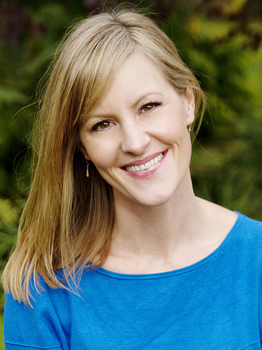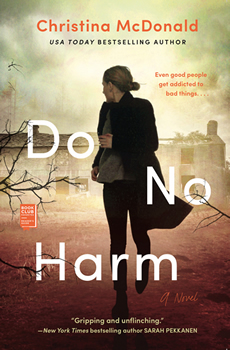DO NO HARM, a standalone domestic thriller by Christina McDonald, intricately weaves fact and fiction to create a fast-paced, tension-filled, compelling novel. The characters are imperfect but relatable.
This book isn’t preachy or condescending—instead, it touches on the current opioid crisis with a candor that is not one sided. Another thread throughout the novel is the struggle faced by Dr. Emma Sweeny as she attempts to balance her personal and professional life.
The story begins when Emma misses identifying the potential signs of cancer in her own child. We soon learn that there is a treatment available which has had tremendous success, but is astronomically expensive. Emma and her husband, a detective, lack the ability to obtain the life-saving procedure for their five-year-old son.
When all traditional avenues of funding fail, she believes it’s up to her to do whatever it takes to acquire the money to save their child’s life. This leads her down a path that places her in direct opposition to the doctor’s hypocritic oath, “do no harm,” and at odds with her husband’s current assignment.
It’s truly a tangled web Emma weaves as she puts everything she’s worked for and her husband’s career on the line to try to save their only child’s life.
In this exclusive interview for The Big Thrill, McDonald shares insight into the inspiration for DO NO HARM, what she enjoys doing in her spare time, and what books you might find on her bedside table.
You received a BA in communications from the University of Washington, an MA in Journalism from the National University of Ireland Galway, and now reside in London— how do you believe each of these experiences has informed your writing?
Having a background in journalism has trained me to look for the plot of my story, and to ask: Why do I care? Why will my reader care? That makes such a difference to the story and to looking at it more objectively. It’s also helped me understand character motivation. As a journalist you really have to understand why a source is telling you something, how their point of view affects what they say. Every person has a reason for their actions, a motivation behind the things they do and say, and being a journalist has taught me to look out for this in my characters, too.
I think living in a number of countries and learning about different cultures and the ways people live outside of America has taught me to be more open-minded about different ways of thinking. There are so many perspectives, so many “right” ways of doing things, and I think traveling and living abroad showed me that looking at other people’s points of view makes my stories stronger.
Do you still write nonfiction?
Not anymore. That’s not to say I would never do it again, but right now it’s just fiction for me.

What do you believe are the most challenging differences in writing fiction versus nonfiction- which do you prefer and why?
I only wrote the one nonfiction book (Moon Living Abroad In Ireland), so it’s difficult to say. I definitely prefer writing fiction because I can be freer in where I go and what my characters do. I’m not a plotter, I’m a pantser, and I think to write nonfiction you need to be quite clear and regimented about what you’re going to say before you start.
My research indicates you are a voracious reader. What is your all-time favorite novel and what are you currently reading?
I’m a huge bookworm! When I was a little girl, I had a corner in my closet that I decorated with drawings and stocked with pillows and blankets, and I would go there to read for hours on end. I’m not sure I have a favorite all-time book; there are so many to choose from. But some of my favorites are My Sister’s Keeper by Jodi Picoult, The Stranger Inside by Lisa Unger, The Good Girl by Mary Kubica, Don’t Look For Me by Wendy Walker. And for nonfiction, When Breath Becomes Air by Paul Kalanithi and Maybe You Should Talk To Someone by Lori Gottlieb.
Right now, I’m reading an advance copy of Robyn Harding’s upcoming thriller, The Perfect Family, and it is incredible. Unsettling and darkly sublime, it explores twisted family dynamics and devastating secrets. It’s a perfect suburban thriller.
What inspired DO NO HARM?
I’ve wanted to set a thriller against the backdrop of the opioid epidemic for a long time because I’ve spent much of my adult life watching my brother’s addiction to opioids. The experience changed me and my view of addiction and opioids.
Then one day I saw a news story about a podiatrist in Indiana who’d been arrested for starting an opioid ring, and it got me thinking. Why do people sell drugs? Why would a doctor sell opioids when our country is suffering so badly from this epidemic? Was it money, power, status? The only thing I thought I could understand was love. My children. I would do anything for them. That was the first moment the seeds for DO NO HARM were planted in my mind.
My protagonist, Emma, isn’t a traditional hero; she’s an anti-hero, and that’s intentional. I wanted to show that there are many in the oxy supply chain to blame for addiction—manufacturers, distributors, lawmakers, pharmacies, doctors—but until the system is fixed, there are opportunists who will continue to use the opioid epidemic for personal gain.
According to your bio, hiking is another activity you enjoy. Have you ever hiked the woods around Skamania or ever visited the waterfall that your characters do?
Skamania is a completely fictional town, but it’s loosely based around the real-life town of Snoqualmie, and the waterfall for which it’s named, Snoqualmie Falls. As a teenager, I spent a lot of time skiing at Snoqualmie Pass, and when I was a kid I visited Snoqualmie Falls and hiked the Snoqualmie Falls Trail with my family many times. So of course, some of the rugged mountainous beauty ended up in DO NO HARM, but the overall atmosphere of my waterfall and the town of Skamania are quite different to Snoqualmie, with a much more malevolent vibe to them.
The protagonist’s brother, Ben, “plucks at his eyebrows” when he’s anxious. I love the visual, but have never seen it used in a novel before. Where did you get the idea for this habit from?
I don’t actually know anyone in real life who does this, so it’s interesting that this compulsion showed up in a character. However, I often get a visual or sometimes just an aura of what my characters look like, and when I closed my eyes and imagined Ben, I saw him with bald patches on his eyebrows. From that I knew he suffered from trichotillomania, which is when a person has an urge to pull out their hair. It’s a type of compulsion usually exacerbated by stress or anxiety. I know from my own brother that addiction is a life-long struggle, and periods of being clean also include periods of high stress. So it made sense to me that Ben would be a stressful, high-strung man with habits and compulsions and twitches to match.
I’m impressed by the accuracy of DO NO HARM (as a former emergency room nurse married to a medical oncologist). While doing research were you surprised or shocked by anything you learned about physicians, insurance companies, or the current opioid crisis?
I did more research for DO NO HARM than any of my other books, including reading medical journals and interviewing doctors and detectives. I was shocked a number of times. Most notably, when I learned that CAR T-cell therapy, which is the type of immunotherapy I write about that Josh needs in DO NO HARM, actually does cost $450,000 – $500,000, and isn’t covered by medical insurance. Because it hadn’t received FDA approval (at time of writing), coverage really was at the discretion of insurance companies, and that seems wholly wrong to me. How can you put a price tag on someone’s life like that, especially a child’s?
I was also surprised by how many medical professionals were charged with illegally selling opioids. I was never surprised by how quickly doctors prescribed opioids—I was readily prescribed opioids for everything from a fender bender to getting my wisdom teeth removed to having a baby—but how many medical professionals illegally sold them was shocking. From doctors to dentists to nurse practitioners, my research showed that this was not uncommon at all. Whether it was for personal gain, for money, or for misguided nobility, like helping out those in pain, so many in the medical industry had illegally sold opioids, and some went as far as actually setting up opioid rings.
The statistics of people affected by the opioid crisis shocks and appalls me on a daily basis. It hasn’t gotten better; in fact, we now have an epidemic within a pandemic, and statistics are unfortunately showing the problem worsening.
What advice do you have in regard to research for aspiring authors?
Research is an important step in writing a novel, even thrillers, which seem like they would be mostly based on imagination. But researching your setting, characters, plot details, and historical influences makes your book more authentic. It’s important to make sure your research is factual and realistic without overwhelming the story. You want to know enough about your subject to write confidently, but not bog the plot down in details. When you know what you’re talking about, your readers will, too.
Reading is your first step, so look at books, newspapers, library archives. Read articles that are reliable, that use fact-based sources themselves. For technical or medical information, I always look for verifiable, scientific sources, like medical journals or scholarly papers. Then I move on to interviewing real people. I speak to sources who actually have experience in the field that I’m writing about, so for DO NO HARM, that meant speaking to a doctor and a detective. Speaking to experts gives valuable firsthand information to use in your book. Lastly, after you finish your book, see if you can get an expert to read it. I had a doctor read DO NO HARM after I’d finished my first draft, and she gave me valuable advice that helped make the story more authentic.

